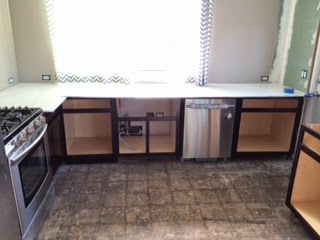While endlessly searching Craigslist, day after day, I stumbled upon a seller selling all wood upper and lower kitchen cabinets. The price was right and I could have them right away! The only drawback, they were honey colored. Minor!
I packed up my husband and brother to do the heavy lifting and off we went to meet the mysterious Craigslist seller. She turned out to be a super nice lady and the cabinets were everything that I wanted them to be! (Despite what others may tell you about those on Craigslist, I have met nothing but super friendly people that are genuinely willing to help you. My husband will tell you that it's just because I'm me and that people are always willing to help me. Maybe I just look super friendly or completely lost and in need of saving, but people seem to respond well to me for some reason. It's probably the latter...lol.)
The cabinet closest to the camera is the original color of the cabinets. It's nice, but just not the color I had in mind.
I had the men load the cabinets into the truck and we headed home. The cabinets came disassembled, so while assembling them I came up with a plan of attack to change the color. I knew that I wanted the grain of the wood to be able to show through, so that meant that painting them was out. The only option left was to stain them in order to achieve the look that I wanted.
Side Note: Staining is a lot of work! There's the prep work (ie. the sanding and the cleaning), then the actual staining (multiple coats with drying time in between each coat), and finally the topcoat (also multiple coats). Thus, I tried to talk myself into just painting the cabinets. It would have been much faster, but the wood grain was so pretty that I just couldn't do it!
After researching various staining techniques and products, I decided to use General Finishes gel stain in Java. It is a stain that sits on top of the wood rather than permeating it like normal stains do. It allowed for less sanding, which I wish I could have avoided all together, but if you want it to look nice then you need to do it right the first time!
Awesome product! It looks exactly like chocolate pudding, but it's not! So don't eat it. ;)
Here's the step-by-step process that I used:
- Sand the parts to be stained until they are no longer shiny. The shiny part is the original top coat, which the gel stain will not stick to. It might stick on the first coat, but once the second coat is applied it all wipes off. Super frustrating! So be sure that you get off all that shiny top coat via sanding before you even think about starting to stain.
- Clean!!! Use your vacuum to suck all of the dust out of any cracks or crevices. The last thing you want is to be staining and a whole bunch of dust puffs out from a crack and onto your nice fresh stain. There's no easy way to come back from that. You'll have to sand it out and start over.
- Apply the first coat of stain. It will look streaky and gross. Don't panic!
- Be sure to wear latex gloves. You don't want stain on your hands or your on your nail polish. The horror!
- For the larger sections you can use an old sock to apply the stain with. With your gloves on first, stick your hand inside the sock. Now you can use the sock as a mitt, dipping it into the stain and wiping it onto the wood.
- Side note: If you stick your used sock into a resealable plastic bag and stick it in the freezer, you can reuse your sock for multiple coats. The freezer keeps the stain from drying. Remember to squish out as much air as you can from the bag.
- For smaller more precise sections (ie. the inside panel of our shaker style cabinet doors) I used a make-up sponge. (Hey, I'm a girl! We use what we know.) The make-up sponge was small and gave me the most control out of any of the other options that I tried. It took longer, but those doors look perfect and smooth!
- Let it dry for the full 24 hours. I tried to rush it and do two coats in one day. Bad idea. If the stain isn't completely dry, the next coat will wipe off the first coat. With this gel stain, slow and steady wins the race.
- Repeat steps 3 and 4 until the desired color is reached. For me that was 3 coats.
- Apply the Gel Topcoat. I used the satin finish, but it does come out more shiny than matte. Use the same application as you did for the stain. I did two coats of topcoat.
This is what it looks like after just one coat of stain.
This is after two coats of stain.
Just a few of the doors I had to stain. You can kind of see the wood grain in this picture.
After two coats on the doors.
Installing the finished cabinets. I opted to only stain the outside that way the inside still looked bright and clean looking with the factory finish.
Fitting the new Corian counter top.
Fitting my Corian farmhouse sink. I love it! You need a farmhouse sink in your life, you really do!
By the way, don't you love my chevron curtains? I sewed those babies myself! Toot, toot...lol.
I loathed the whole staining process while I was in it. Now looking back on it, I would do it again in a heartbeat. That's how much I love the results. If you're holding back on staining or even just repainting your current cabinets, you should go for it. It's a big project, but so totally worth the work.














No comments:
Post a Comment